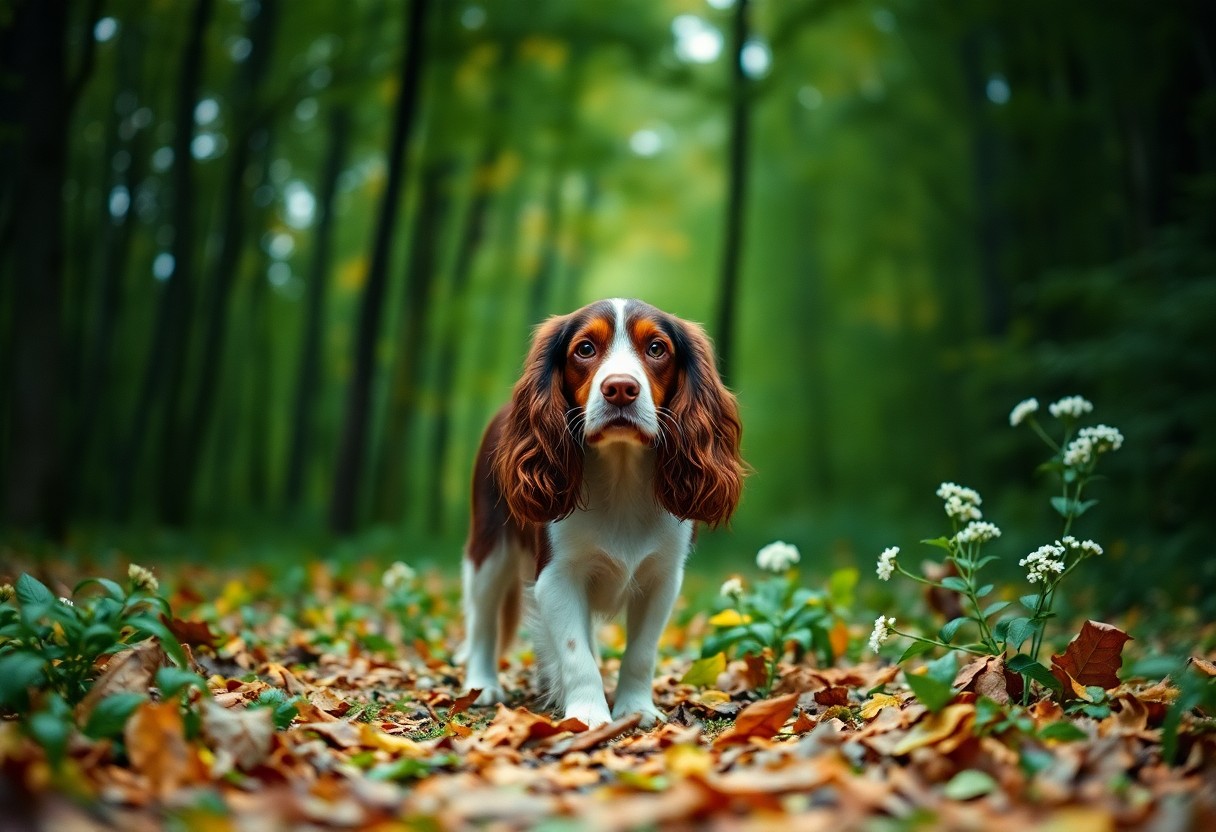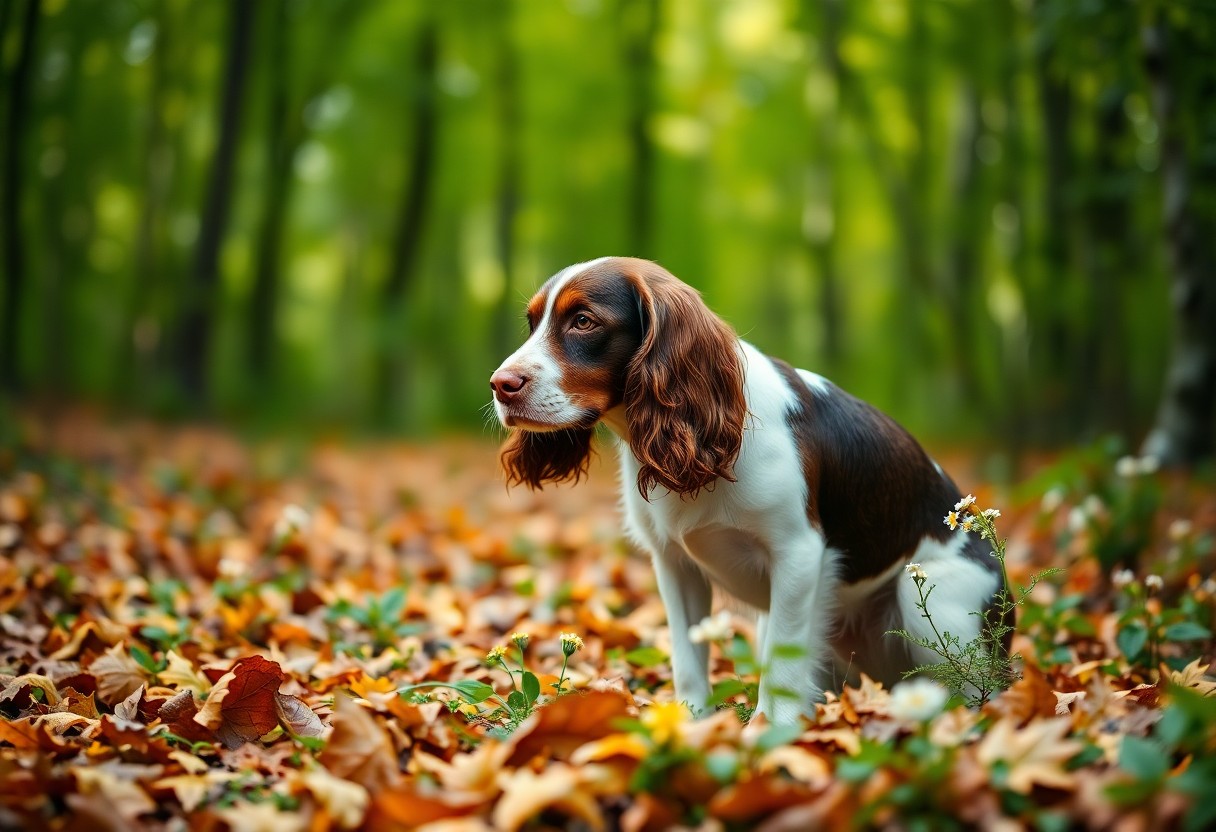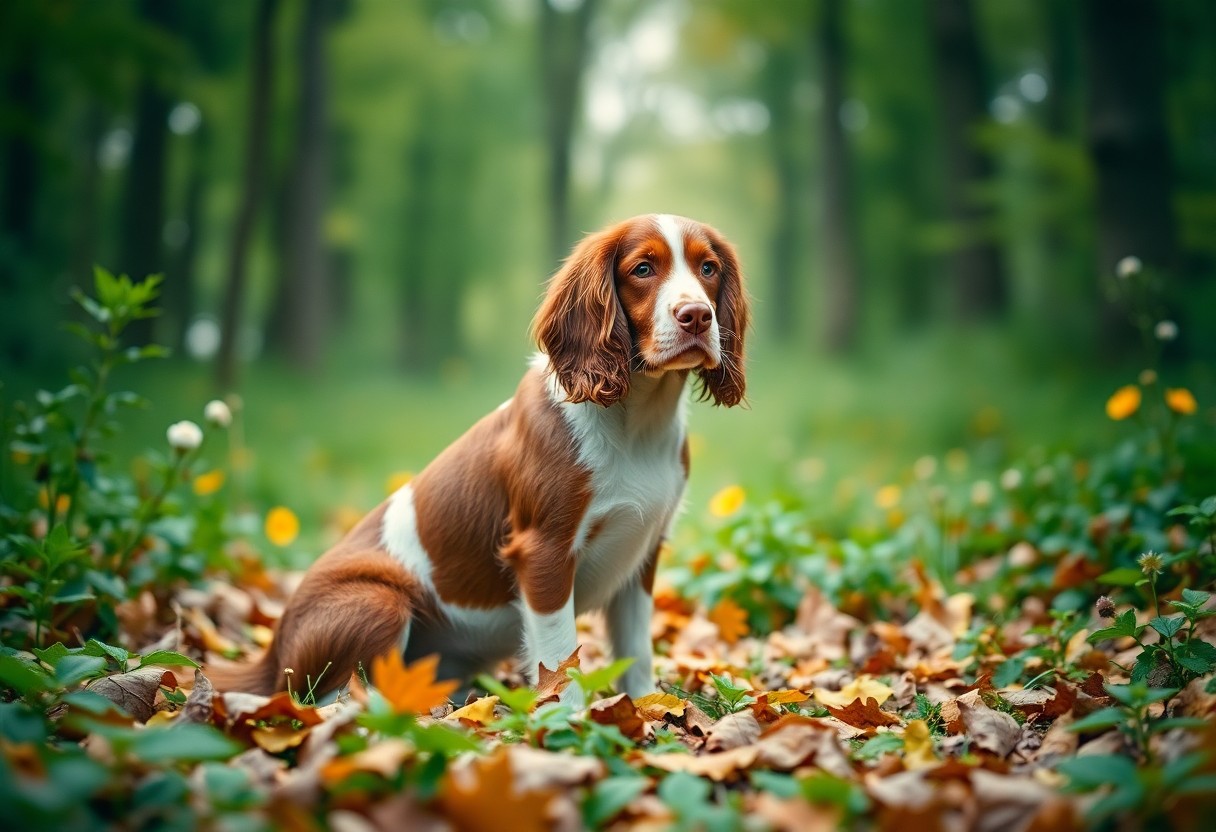Welsh garthechion, or Welsh Springer Spaniel, is a breed that showcases an outstanding combination of intelligence and versatility in the hunting field. If you are considering a companion for your outdoor adventures, this dog excels in both upland and waterfowl hunting, making it a perfect fit for various hunting styles. With their affectionate nature and strong work ethic, these dogs not only serve as loyal companions but are also highly trainable. Get ready to learn how this remarkable breed can enhance your hunting experience.
Key Takeaways:
- Welsh Springer Spaniels are known for their excellent hunting and tracking abilities, making them versatile working dogs.
- This breed thrives in active environments and requires regular exercise and mental stimulation.
- Welsh Springer Spaniels are known for their friendly and affectionate nature, making them great family pets.
- They have a distinctive reddish-brown and white coat that requires regular grooming to maintain its health and appearance.
- Socialization from a young age is important to develop their friendly temperament and prevent any wariness towards strangers.
- These dogs are intelligent and eager to please, which aids in training and learning new commands and tasks.
- Welsh Springer Spaniels can adapt to various roles beyond hunting, including therapy and agility activities, due to their versatility.
History of the Welsh Springer Spaniel
For over a century, the Welsh Springer Spaniel has been recognized for its remarkable hunting abilities and charming demeanor. To learn more, Get to know the Welsh Springer – WSSCA showcases the breed’s rich history and characteristics.
Origin and Development
After originating in Wales, the Welsh Springer Spaniel developed as a versatile hunting dog, primarily used to flush game from dense cover. Its lineage can be traced back several centuries, reflecting a blend of local spaniel types and influences from other breeds.
Historical Roles in Hunting
Above all, the Welsh Springer Spaniel has been cherished for its role in hunting. Utilized by hunters for flushing birds and retrieving game from land and water, this breed has displayed exceptional agility and intelligence. Your connection with this dog can elevate your hunting experience, as they work tirelessly to expertly locate and bring back your quarry.
Considering the spaniel’s versatile nature, it is known not only for its ability to navigate challenging terrain but also for its strong scenting ability. These skills make them particularly valuable in various hunting environments, from dense forests to open fields. Their *endurance* and keen instincts can prove *vital*, ensuring that your hunting adventures are both successful and enjoyable. This breed’s history is deeply intertwined with the traditions of hunting, highlighting their place in the hearts of hunting enthusiasts.
Physical Characteristics
Some of the most notable physical characteristics of the Welsh Springer Spaniel include a balanced and athletic build, designed for agility and stamina in hunting scenarios. These dogs usually exhibit a well-proportioned body, a friendly expression, and a lively demeanor. Their overall appearance conveys both strength and grace, making them a striking presence in the field as well as a delightful companion at home.
Size and Build
Against the backdrop of varying dog breeds, the Welsh Springer Spaniel typically stands 18 to 20 inches tall at the shoulder and weighs between 35 to 50 pounds. This size allows them to navigate diverse terrains comfortably, while their strong yet agile build enables them to excel in various hunting tasks. You will find their structure is both compact and robust, providing durability and energy for long days in the field.
Coat and Coloration
Against the typical coat spectrum of dog breeds, the Welsh Springer Spaniel sports a beautiful, medium-length coat that is both water-resistant and protective. These dogs exhibit a striking combination of red and white colors, with a distinct pattern that includes a solid red body and white markings. This unique coloration not only adds to their aesthetic appeal but also serves a practical purpose in the field.
Due to their unique medium-length, water-resistant coat, Welsh Springer Spaniels require regular grooming to maintain its health and appearance. This coat is designed to protect them from the elements while hunting, ensuring they stay dry and comfortable during long hours outdoors. The breed typically comes in a rich reddish hue with white markings, which enhances visibility in the field, thereby aiding in the visibility for both you and your dog. Awareness of the grooming needs and coat characteristics is vital to ensure your dog remains both stunning and well-cared-for.
Temperament and Personality
After years of breeding, the Welsh Springer Spaniel has developed a friendly and affectionate temperament, making it an ideal companion for families and individuals alike. Known for their high energy and playful nature, these dogs thrive on social interaction and require regular mental and physical stimulation to stay happy. You can learn more about their traits and characteristics in the Welsh Springer Spaniel – All About Dogs resource.
General Disposition
Beside their playful nature, Welsh Springer Spaniels exhibit a strong loyalty to their families. They can be affectionate with their owners while remaining vigilant when necessary, making them quite adaptable. Their eagerness to please and intelligence make training them relatively easy, though consistency is key.
Behavior with Families and Children
One notable aspect of the Welsh Springer Spaniel is their gentle demeanor around families and children. They are known to be playful and loving, often developing strong bonds with their family members. Their friendly disposition allows them to interact well with kids, while their high energy levels encourage active playtime and engagement. However, it’s important to supervise interactions to ensure a safe environment, especially for young children, as their exuberance might be overwhelming at times.
General characteristics show that while these dogs are affectionate and energetic, it’s crucial to train them from an early age. This helps them learn to respect personal space and boundaries with both children and adults. Maintaining consistent rules and providing structure will enhance their positive traits, making them a cherished addition to your home.
Training and Socialization
Keep in mind that training and socialization are key elements in shaping a well-behaved Welsh Springer Spaniel. This breed thrives on mental and physical stimulation, so introducing structured training sessions will not only enhance obedience but also strengthen the bond between you and your dog. Starting early will yield the best results, as these dogs are eager to please and respond well to positive reinforcement techniques.
Basic Obedience Training
Basic obedience training should begin as soon as you welcome your Welsh Springer Spaniel into your home. Teaching fundamental commands such as “sit,” “stay,” and “come” is important for establishing behavior expectations. Incorporate short, engaging training sessions that use positive reinforcement techniques, like treats and praise, to motivate your dog and promote learning.
Socialization Needs
Socialization is equally important for your Welsh Springer Spaniel, as it helps them develop into a well-rounded adult dog. Actively exposing your dog to various environments, people, and other animals during their early months fosters confidence and reduces the likelihood of behavioral issues.
In addition, prioritize a variety of experiences during your dog’s formative weeks, such as visiting parks, meeting other dogs, and interacting with different people. This kind of positive exposure not only helps your dog feel comfortable in diverse situations but also aids in minimizing fear-related behaviors. Skipping socialization can lead to aggression or anxiety, which may strain your relationship. Thus, ensuring your Welsh Springer Spaniel embraces new challenges will contribute to their happiness and the overall harmony in your household.
Health and Care
Not all breeds are created equal when it comes to health, and the Welsh Springer Spaniel is no exception. Regular veterinary check-ups, a balanced diet, and adequate exercise are crucial to keep your dog healthy. Be attentive to any changes in behavior or physical condition, as these can indicate underlying health issues. Maintaining a consistent care routine will ensure that your Welsh Springer remains fit and active through all stages of life.
Common Health Issues
Any breed can face a variety of health concerns, and Welsh Springer Spaniels are no different. They may be prone to conditions like hip dysplasia, ear infections, and certain eye disorders. It’s vital to monitor your dog for symptoms and consult a veterinarian promptly for any abnormal signs. Early diagnosis can lead to better management of these conditions.
Grooming and Maintenance
At least once a week, you should groom your Welsh Springer Spaniel to keep its coat healthy and shiny. This breed has a medium-length, wavy coat that requires regular brushing to prevent mats and tangles. Don’t forget to check and clean their ears regularly, as they are prone to infections, and ensure their nails are trimmed to avoid discomfort.
The Welsh Springer Spaniel benefits from regular grooming, which is crucial for maintaining their beautiful coat and preventing skin issues. Brush your dog at least once a week to remove loose hair and debris, and use a soft brush to avoid irritating their skin. Bathing should be done as needed but be careful not to overdo it, as it can strip their coat of natural oils. Additionally, keep an eye on their ears, as the breed’s floppy ears can trap moisture and lead to infections. Overall, a consistent grooming routine contributes significantly to your dog’s overall health and well-being.
Versatility in Hunting
Now, the Welsh Springer Spaniel is celebrated for its remarkable versatility in hunting scenarios. This breed excels in diverse environments, whether you’re flushing game in dense cover or tracking in open fields. Its keen instincts, agile movement, and stamina make it an invaluable companion for any hunter. To learn more about how The Welsh Springer Spaniel – Gun Dog adapts to various hunting tasks, explore the details below.
Fieldwork and Performance
Between the flush of game and its retrieval, the Welsh Springer Spaniel showcases impressive performance on the field. Its strong work ethic and eagerness to please contribute to its success in both hunting and trials, making it a highly regarded choice among sportsmen.
Adaptability to Different Game
Along with its excellent skills in fieldwork, this breed’s adaptability to various types of game sets it apart. From upland birds to waterfowl, the Welsh Springer Spaniel can handle different hunting scenarios with finesse.
Performance is where the Welsh Springer Spaniel truly shines, showcasing its exceptional versatility across hunting environments. Whether you’re pursuing upland game, waterfowl, or even small mammals, this breed demonstrates both intelligence and adaptability. Its buoyant temperament and keen nose make it equally effective both in the field and during trials. You’ll appreciate the ease with which your Welsh Springer transitions from one type of game to another, ensuring a successful and enjoyable hunting experience every time you step outside.
To wrap up
Summing up, the Welsh Springer Spaniel is not only a delightful companion but also a highly versatile hunting dog that excels in various environments. You can appreciate their intelligence and eagerness to please, making them highly trainable for hunting tasks. With their natural instinct for retrieving and a gentle demeanor, these dogs are perfect for both novice and seasoned hunters alike. Embracing a Welsh Springer Spaniel in your life means embracing an active, loyal partner ready to help you on your outdoor adventures.
FAQ
Q: What is the origin of the Welsh Springer Spaniel?
A: The Welsh Springer Spaniel is believed to have originated in Wales, where it was developed as a versatile hunting dog. Historical records suggest that they were used by hunters for flushing game in the 17th century. Their lineage is closely related to various other spaniels, showcasing their deep-rooted history in hunting and retrieving activities.
Q: What are the key characteristics of the Welsh Springer Spaniel?
A: Welsh Springer Spaniels are medium-sized dogs with a distinct coat that is typically a rich red and white color. They possess a sturdy build, with a long, expressive head and drooping ears. Their temperament is friendly, eager to please, and they are known for their energetic nature. These dogs are also highly intelligent, making them excellent companions for active families.
Q: What is their exercise requirement?
A: Welsh Springer Spaniels are energetic and active dogs that require regular exercise to stay healthy and happy. Daily activities should include walks, playtime, and opportunities for mental stimulation. They thrive in environments where they can engage in physical challenges, such as fetching games or agility training. Ideally, they need at least an hour of exercise each day.
Q: How do they perform in hunting scenarios?
A: As versatile hunting dogs, Welsh Springer Spaniels excel in various hunting scenarios, particularly in flushing and retrieving game. Their keen sense of smell and natural hunting instincts make them skilled trackers. They have a strong work ethic and are known to work closely with their handlers, making them reliable companions in both fieldwork and shooting situations.
Q: Are Welsh Springer Spaniels good family dogs?
A: Yes, Welsh Springer Spaniels are known to be excellent family dogs. They are affectionate, loyal, and social in nature, making them great companions for children and other pets. Their friendly demeanor and gentle temperament help them build strong bonds within a family, provided they receive proper training and socialization from a young age.
Q: What grooming needs do Welsh Springer Spaniels have?
A: Welsh Springer Spaniels require regular grooming to maintain their coat’s health and appearance. Their medium-length, wavy coat should be brushed at least once a week to prevent matting and to control shedding. During shedding seasons, more frequent brushing may be necessary. Regular checks on their ears and teeth are also recommended to ensure overall hygiene.
Q: What health issues should owners be aware of?
A: Like many breeds, Welsh Springer Spaniels can be prone to certain health issues. Common concerns may include hip dysplasia, ear infections, and eye conditions such as cataracts. Regular veterinary check-ups, a nutritious diet, and proper exercise can help mitigate these risks. Potential owners should also seek reputable breeders who prioritize health testing in their breeding practices.


